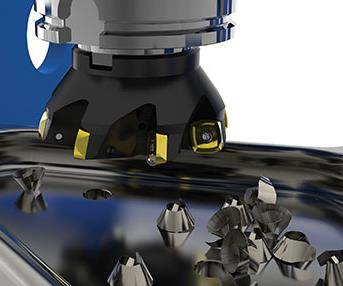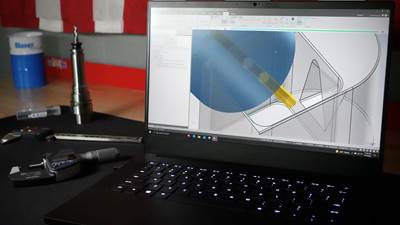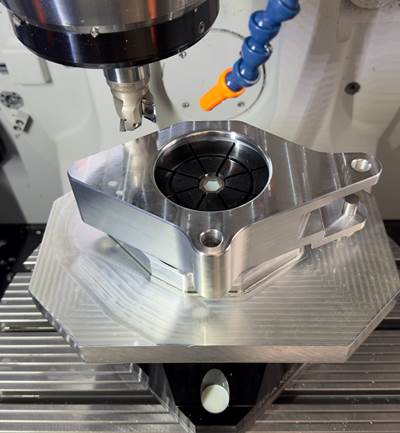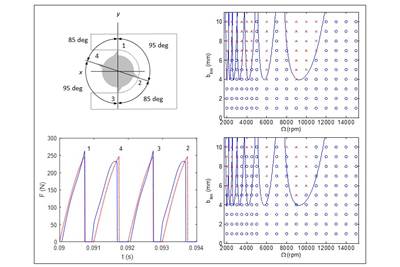-
-
SPONSORED
-
SPONSORED
-
Milling Tools
Milling is a complex metal removal process that usually involves a clamped workpiece being fed in a linear direction into a multiple tooth rotating cutter. Due to the vast variety of machinery, controls and tools that are available, milling is one of the universal machining methods of choice. It offers excellent machining efficiency, good surface finishes, great flexibility and a high degree of accuracy. While turning is frequently used to create round surfaces with a single cutting edge, milling normally uses several cutting edges in a single tool to create flat faces, shoulders, slots and contoured surfaces. There are many types of machine tools used to perform a milling operation, including manually controlled, numerically controlled and special dedicated machines.



ESSENTIAL READING
VIEW ALLRoughing First: New Strategies for Blisk Machining
Aerospace shops looking to cut cycle time and tool wear on integrally bladed rotors often focus on finishing. But rethinking the roughing stage can increase how much material can be safely removed while accelerating throughput.
Read MoreUnderstanding Process Damping in Milling Operations
Despite the advances in modeling machining operations over the past decades, process damping remains a topic of interest, including new tool designs that increase the effect.
Read More10 Tips for Titanium
Simple process considerations can increase your productivity in milling titanium alloys.
Read MoreA New Milling 101: Milling Forces and Formulas
The forces involved in the milling process can be quantified, thus allowing mathematical tools to predict and control these forces. Formulas for calculating these forces accurately make it possible to optimize the quality of milling operations.
Read MoreHow to Tackle Tough Angled Pocket Milling With Two Tools
Milling a deep pocket with a tight corner radius comes with unique challenges, but using both a flat bottom drill and a necked-down finishing tool can help.
Read MoreChoosing Your Carbide Grade: A Guide
Without an international standard for designating carbide grades or application ranges, users must rely on relative judgments and background knowledge for success.
Read MoreLatest Milling Tools News And Updates
Sandvik Coromant Solid End Mill Enhances Profiling Efficiency
Sandvik Coromant’s Coromill Plura Barrel end mill is designed for high process security and significant cycle time reductions in aerospace and other high-demand sectors.
Read MoreOSG Tooling Lineup Features Optimized Milling, Drilling Tools
OSG has expanded several of its end mills series, including the A Brand AE-CPR2-H, A Brand AE-CPR4-H and Exocarb WXL-EBM end mills, as well as its A Brand ADO-40D and 50D drill series, and the Pheonix indexable series.
Read MoreCeratizit Milling Tool Minimizes Machining Vibrations
Ceratizit’s MonsterMill milling tools provide smooth cutting action in difficult-to-machine alloys.
Read MoreSchwanog Tooling Lineup Provides Productive Machining of Precision Parts
Schwanog’s milling and grooving lineup includes efficient, custom solutions for a wide range of applications.
Read MoreGreenleaf End Mills Optimize Machining Stability
Capstone-360 end mills are well suited for machining HRSAs, cast iron and hardened steel materials for the aerospace, oil and gas, power generation and medical industries.
Read MoreEmuge-Franken End Mills Provide High Metal Removal Rates
TiNox-Cut VAR end mills are designed for hard-to-cut materials from stainless steel and titanium to Inconel and nickel alloys.
Read MoreFeatured Posts
Understanding Process Damping in Milling Operations
Despite the advances in modeling machining operations over the past decades, process damping remains a topic of interest, including new tool designs that increase the effect.
Read MorePicking the Right End Mill
Kennametal global product manager Katie Myers explains how cutting tool features can impact machining strategies for different materials.
Read MoreShoulder Milling Cuts Racing Part's Cycle Time By Over 50%
Pairing a shoulder mill with a five-axis machine has cut costs and cycle times for one of TTI Machine’s parts, enabling it to support a niche racing community.
Read MoreThe Impact of Cutting Teeth Spacing on Machining Stability
Many cutter designs are available, and variable teeth spacing (or variable pitch) cutters can be used to influence milling stability. Let’s discuss why teeth spacing affects stability.
Read MoreGrooving Attachment Streamlines Operation by 75%
A grooving attachment enabled Keselowski Advanced Manufacturing to reduce cycle times by over 45 minutes on a high-value, high-nickel part feature.
Read MoreFAQ: Milling Tools
What is milling?
At its most basic, milling is the meeting of a rotating tool with a clamped and stationary workpiece, as opposed to turning where the tool is stationary and the work material rotates. Actually, the workpiece has feed motion imparted from the machine tool. The meeting of the rotary motion of the cutter and the cutting edge of the tools produces fluctuating cutting forces: vibration, heat, and, if all goes well, chips.
Source: A New Milling 101: What Milling Is, Then and Now (Plus a Glossary of Milling Terms)
What is a milling machine?
Milling machines may have either vertical or horizontal spindle orientation, and typically, face milling cuts flat surfaces, but multi-axis CNC machines make it possible to include three-dimensional movements. That said, there are four basic categories of milling: face milling, periphery milling, slot milling, and specialty applications.
Source: A New Milling 101: What Milling Is, Then and Now (Plus a Glossary of Milling Terms)
What are the basic categories of milling?
Face milling: Used for creating a flat surface (face) on the workpiece. The cutting plane is usually perpendicular to the axis of rotation and the cutters most often feature a single row of inserts, designed with a wide range of cutting geometries, inserts, lead angles, and mounting adaptations.
Periphery milling: Generates a primary surface parallel to the spindle rotation. A secondary surface is sometimes produced. The cutting plane is usually parallel to the axis of rotation.
Slot milling: Used for producing a slot or channel in the workpiece. There are two primary types of slot milling cutters: disk mills and end mills. Disk mills can be high-speed steel, brazed carbide, and indexable-insert-based. They are typically used in operations perpendicular to the spindle rotation.
Specialty applications: Includes copy milling, plunge milling, ramping, helical and circular interpolation, trochoidal, and others.
Source: A New Milling 101: What Milling Is, Then and Now (Plus a Glossary of Milling Terms)








































.png;maxWidth=300;quality=90)







